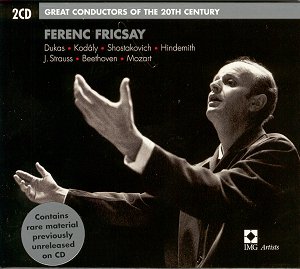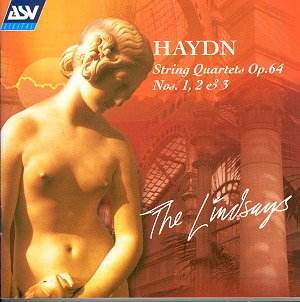 Composer: Ferenc Fricsay
Composer: Ferenc Fricsay
Works: Paul Dukas – L’Apprenti sorcier; Zoltán Kodály – Dances of Galánta; Dimitri Shostakovich – Symphony No. 9; Paul Hindemith – Symphonic Metamorphoses of themes of Carl Maria von Weber; Johann Strauss II – Waltz: The Artist’s Life; Ludwig van Beethoven – Overture: Leonore No. 3; Symphony No. 3 ‘Eroica’; Wolfgang Amadeus Mozart – Overture: Così fan tutte
Performers: Berlin Radio Symphony Orchestra; RIAS Symphony Orchestra; Vienna Philharmonic Orchestra
Recording: Various dates, 1950-1961, Grosser Sendesaal, Berlin; Jesus Christus Kirche, Berlin; Salzburg Festival
Label: EMI Classics/IMG Artists
Ferenc Fricsay, a formidable force in mid-20th-century conducting, left an indelible mark on the orchestral landscape before his untimely passing in 1963. His unique ability to blend traditional repertoire with lesser-known works is exemplified in this two-disc set, which captures performances that reflect his innovative spirit and interpretative depth. The recordings offer a compelling glimpse into a vibrant musical milieu, particularly during the post-war years in Berlin, where Fricsay’s artistry flourished amid challenging conditions.
The collection opens with Paul Dukas’s L’Apprenti sorcier, a piece that demands both precision and a vivid orchestral palette. Fricsay’s interpretation, recorded in 1961, is marked by a keen sense of drama and color, successfully navigating the work’s intricate textures and dynamic contrasts. The orchestra delivers a vibrant sonic tapestry, effectively bringing to life the magical narrative. Similarly, the Dances of Galánta by Kodály, also from 1961, benefits from Fricsay’s energetic conducting style. He imbues the music with a buoyant rhythm and a lively spirit, allowing the rich Hungarian folk influences to resonate with clarity and exuberance.
The 1954 recording of Shostakovich’s Symphony No. 9 stands out as a remarkable achievement in this set. In a time when the symphony was still considered daring and avant-garde, Fricsay imparts a youthful vitality to the music, balancing the work’s satirical undertones with a refined sense of commitment. The recording quality here is commendable, capturing the buoyancy of the RIAS Symphony Orchestra, though some early recordings from this era lack the sonic clarity of more contemporary efforts. Hindemith’s Symphonic Metamorphoses, however, suffers somewhat from this recording’s limitations; the brilliance and rhythmic incisiveness of Fricsay’s conducting are unfortunately dimmed by the sound quality, failing to fully convey the work’s wit and charm.
Transitioning to the Beethoven selections on CD2, Fricsay’s Leonore No. 3 overture captivates with its dramatic tension and careful phrasing. The interpretation balances urgency with lyrical beauty, showcasing the conductor’s sensitivity to the music’s evolving emotional landscape. Yet, the subsequent Eroica Symphony reveals a mixed bag. The opening chord lacks the precision one might expect, though Fricsay successfully builds momentum thereafter. His approach to the slow movement is a matter of taste; it unfolds with a certain gravitas that may feel protracted against the more brisk interpretations prevalent today. Nevertheless, the final movements are invigorating, with the Berlin horns particularly shining in the scherzo, highlighting the ensemble’s virtuosic capabilities.
The disc closes with Mozart’s Così fan tutte overture, which, while well-shaped, shows signs of age in tonal focus. This inconsistency across the recordings is emblematic of the challenges faced by Fricsay during his career, particularly in the early post-war recording landscape. Despite the variable sound quality, the documentation and production standards in this release are commendable, providing valuable context and insight into Fricsay’s artistry.
Fricsay’s contributions to the orchestral repertoire are underscored in this collection, which, despite its sonic limitations, illuminates his interpretative genius and the vibrant orchestral culture of his time. While some recordings may not rival contemporary standards, the performances are imbued with a palpable energy and insight that resonate with historical significance. This set is a worthwhile exploration for those seeking to understand the legacy of one of the 20th century’s great conductors.



